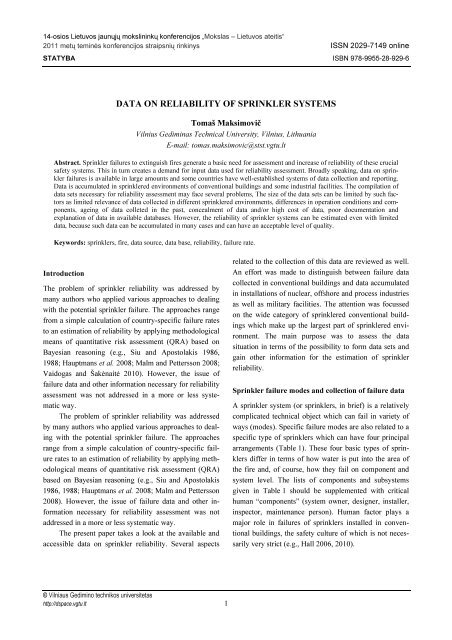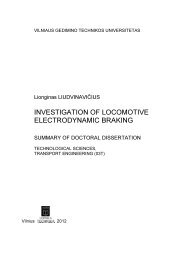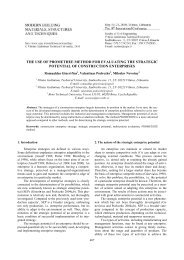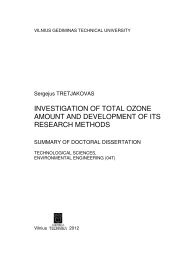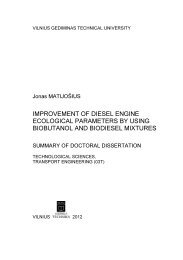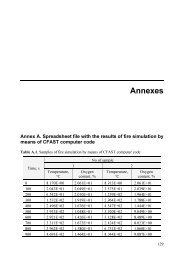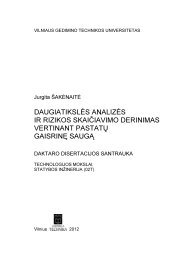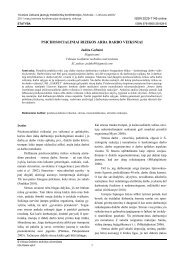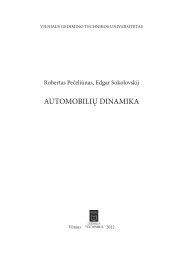data on reliability of sprinkler systems - Vilniaus Gedimino technikos ...
data on reliability of sprinkler systems - Vilniaus Gedimino technikos ...
data on reliability of sprinkler systems - Vilniaus Gedimino technikos ...
You also want an ePaper? Increase the reach of your titles
YUMPU automatically turns print PDFs into web optimized ePapers that Google loves.
14-osios Lietuvos jaunųjų mokslininkų k<strong>on</strong>ferencijos „Mokslas – Lietuvos ateitis“<br />
2011 metų teminės k<strong>on</strong>ferencijos straipsnių rinkinys ISSN 2029-7149 <strong>on</strong>line<br />
STATYBA ISBN 978-9955-28-929-6<br />
DATA ON RELIABILITY OF SPRINKLER SYSTEMS<br />
Tomaš Maksimovič<br />
Vilnius Gediminas Technical University, Vilnius, Lithuania<br />
E-mail: tomas.maksimovic@stst.vgtu.lt<br />
Abstract. Sprinkler failures to extinguish fires generate a basic need for assessment and increase <strong>of</strong> <strong>reliability</strong> <strong>of</strong> these crucial<br />
safety <strong>systems</strong>. This in turn creates a demand for input <str<strong>on</strong>g>data</str<strong>on</strong>g> used for <strong>reliability</strong> assessment. Broadly speaking, <str<strong>on</strong>g>data</str<strong>on</strong>g> <strong>on</strong> <strong>sprinkler</strong><br />
failures is available in large amounts and some countries have well-established <strong>systems</strong> <strong>of</strong> <str<strong>on</strong>g>data</str<strong>on</strong>g> collecti<strong>on</strong> and reporting.<br />
Data is accumulated in <strong>sprinkler</strong>ed envir<strong>on</strong>ments <strong>of</strong> c<strong>on</strong>venti<strong>on</strong>al buildings and some industrial facilities. The compilati<strong>on</strong> <strong>of</strong><br />
<str<strong>on</strong>g>data</str<strong>on</strong>g> sets necessary for <strong>reliability</strong> assessment may face several problems, The size <strong>of</strong> the <str<strong>on</strong>g>data</str<strong>on</strong>g> sets can be limited by such factors<br />
as limited relevance <strong>of</strong> <str<strong>on</strong>g>data</str<strong>on</strong>g> collected in different <strong>sprinkler</strong>ed envir<strong>on</strong>ments, differences in operati<strong>on</strong> c<strong>on</strong>diti<strong>on</strong>s and comp<strong>on</strong>ents,<br />
ageing <strong>of</strong> <str<strong>on</strong>g>data</str<strong>on</strong>g> colleted in the past, c<strong>on</strong>cealment <strong>of</strong> <str<strong>on</strong>g>data</str<strong>on</strong>g> and/or high cost <strong>of</strong> <str<strong>on</strong>g>data</str<strong>on</strong>g>, poor documentati<strong>on</strong> and<br />
explanati<strong>on</strong> <strong>of</strong> <str<strong>on</strong>g>data</str<strong>on</strong>g> in available <str<strong>on</strong>g>data</str<strong>on</strong>g>bases. However, the <strong>reliability</strong> <strong>of</strong> <strong>sprinkler</strong> <strong>systems</strong> can be estimated even with limited<br />
<str<strong>on</strong>g>data</str<strong>on</strong>g>, because such <str<strong>on</strong>g>data</str<strong>on</strong>g> can be accumulated in many cases and can have an acceptable level <strong>of</strong> quality.<br />
Keywords: <strong>sprinkler</strong>s, fire, <str<strong>on</strong>g>data</str<strong>on</strong>g> source, <str<strong>on</strong>g>data</str<strong>on</strong>g> base, <strong>reliability</strong>, failure rate.<br />
Introducti<strong>on</strong><br />
The problem <strong>of</strong> <strong>sprinkler</strong> <strong>reliability</strong> was addressed by<br />
many authors who applied various approaches to dealing<br />
with the potential <strong>sprinkler</strong> failure. The approaches range<br />
from a simple calculati<strong>on</strong> <strong>of</strong> country-specific failure rates<br />
to an estimati<strong>on</strong> <strong>of</strong> <strong>reliability</strong> by applying methodological<br />
means <strong>of</strong> quantitative risk assessment (QRA) based <strong>on</strong><br />
Bayesian reas<strong>on</strong>ing (e.g., Siu and Apostolakis 1986,<br />
1988; Hauptmans et al. 2008; Malm and Petterss<strong>on</strong> 2008;<br />
Vaidogas and Šakėnaitė 2010). However, the issue <strong>of</strong><br />
failure <str<strong>on</strong>g>data</str<strong>on</strong>g> and other informati<strong>on</strong> necessary for <strong>reliability</strong><br />
assessment was not addressed in a more or less systematic<br />
way.<br />
The problem <strong>of</strong> <strong>sprinkler</strong> <strong>reliability</strong> was addressed<br />
by many authors who applied various approaches to dealing<br />
with the potential <strong>sprinkler</strong> failure. The approaches<br />
range from a simple calculati<strong>on</strong> <strong>of</strong> country-specific failure<br />
rates to an estimati<strong>on</strong> <strong>of</strong> <strong>reliability</strong> by applying methodological<br />
means <strong>of</strong> quantitative risk assessment (QRA)<br />
based <strong>on</strong> Bayesian reas<strong>on</strong>ing (e.g., Siu and Apostolakis<br />
1986, 1988; Hauptmans et al. 2008; Malm and Petterss<strong>on</strong><br />
2008). However, the issue <strong>of</strong> failure <str<strong>on</strong>g>data</str<strong>on</strong>g> and other informati<strong>on</strong><br />
necessary for <strong>reliability</strong> assessment was not<br />
addressed in a more or less systematic way.<br />
The present paper takes a look at the available and<br />
accessible <str<strong>on</strong>g>data</str<strong>on</strong>g> <strong>on</strong> <strong>sprinkler</strong> <strong>reliability</strong>. Several aspects<br />
related to the collecti<strong>on</strong> <strong>of</strong> this <str<strong>on</strong>g>data</str<strong>on</strong>g> are reviewed as well.<br />
An effort was made to distinguish between failure <str<strong>on</strong>g>data</str<strong>on</strong>g><br />
collected in c<strong>on</strong>venti<strong>on</strong>al buildings and <str<strong>on</strong>g>data</str<strong>on</strong>g> accumulated<br />
in installati<strong>on</strong>s <strong>of</strong> nuclear, <strong>of</strong>fshore and process industries<br />
as well as military facilities. The attenti<strong>on</strong> was focussed<br />
<strong>on</strong> the wide category <strong>of</strong> <strong>sprinkler</strong>ed c<strong>on</strong>venti<strong>on</strong>al buildings<br />
which make up the largest part <strong>of</strong> <strong>sprinkler</strong>ed envir<strong>on</strong>ment.<br />
The main purpose was to assess the <str<strong>on</strong>g>data</str<strong>on</strong>g><br />
situati<strong>on</strong> in terms <strong>of</strong> the possibility to form <str<strong>on</strong>g>data</str<strong>on</strong>g> sets and<br />
gain other informati<strong>on</strong> for the estimati<strong>on</strong> <strong>of</strong> <strong>sprinkler</strong><br />
<strong>reliability</strong>.<br />
Sprinkler failure modes and collecti<strong>on</strong> <strong>of</strong> failure <str<strong>on</strong>g>data</str<strong>on</strong>g><br />
A <strong>sprinkler</strong> system (or <strong>sprinkler</strong>s, in brief) is a relatively<br />
complicated technical object which can fail in variety <strong>of</strong><br />
ways (modes). Specific failure modes are also related to a<br />
specific type <strong>of</strong> <strong>sprinkler</strong>s which can have four principal<br />
arrangements (Table 1). These four basic types <strong>of</strong> <strong>sprinkler</strong>s<br />
differ in terms <strong>of</strong> how water is put into the area <strong>of</strong><br />
the fire and, <strong>of</strong> course, how they fail <strong>on</strong> comp<strong>on</strong>ent and<br />
system level. The lists <strong>of</strong> comp<strong>on</strong>ents and sub<strong>systems</strong><br />
given in Table 1 should be supplemented with critical<br />
human “comp<strong>on</strong>ents” (system owner, designer, installer,<br />
inspector, maintenance pers<strong>on</strong>). Human factor plays a<br />
major role in failures <strong>of</strong> <strong>sprinkler</strong>s installed in c<strong>on</strong>venti<strong>on</strong>al<br />
buildings, the safety culture <strong>of</strong> which is not necessarily<br />
very strict (e.g., Hall 2006, 2010).<br />
© <strong>Vilniaus</strong> <strong>Gedimino</strong> <strong>technikos</strong> universitetas<br />
http://dspace.vgtu.lt 1
Table 1. Four basic types <strong>of</strong> <strong>sprinkler</strong> <strong>systems</strong> (compiled from SFPE 2002)<br />
Type<br />
Wet pipe<br />
system<br />
Dry pipe<br />
system<br />
Deluge<br />
system<br />
Preacti<strong>on</strong><br />
system<br />
Principal comp<strong>on</strong>ents/sub<strong>systems</strong><br />
Water supply from the main (water tank); gate valve to c<strong>on</strong>trol water supply to<br />
system; alarm valve; piping network; <strong>sprinkler</strong> heads<br />
Water supply from the main (water tank); gate valve to c<strong>on</strong>trol water supply to<br />
system; dry pipe valve; piping network; <strong>sprinkler</strong> heads<br />
Water supply from the main (water tank); main c<strong>on</strong>trol valve; electric <strong>sprinkler</strong><br />
alarm; deluge valve; release valve; smoke detector; thermal detector;<br />
c<strong>on</strong>trol panel; piping network; battery cabinet<br />
Water supply from the main (water tank); main c<strong>on</strong>trol valve; electric <strong>sprinkler</strong><br />
alarm; deluge valve; check valve; air supply; smoke detector; thermal<br />
detector; c<strong>on</strong>trol panel; piping network; battery cabinet; closed <strong>sprinkler</strong> head;<br />
system maintaining small fire pressure in the fire network<br />
No <strong>of</strong> comp<strong>on</strong>ents/sub<strong>systems</strong><br />
5<br />
5<br />
10<br />
10<br />
C<strong>on</strong>tributi<strong>on</strong> <strong>of</strong> failures <strong>on</strong> the comp<strong>on</strong>ent level to<br />
the <strong>sprinkler</strong> system failure is represented by means <strong>of</strong><br />
fault tree diagrams (Rönty et al. 2004; Hauptmans et al.<br />
2008). Both identificati<strong>on</strong> <strong>of</strong> system failure modes and<br />
development <strong>of</strong> fault tree diagrams for them will reveal<br />
what <str<strong>on</strong>g>data</str<strong>on</strong>g> is necessary for the estimati<strong>on</strong> <strong>of</strong> system <strong>reliability</strong>.<br />
A unified and, ideally, world-wide classificati<strong>on</strong><br />
<strong>of</strong> causes and modes <strong>of</strong> <strong>sprinkler</strong> failures could improve<br />
the collecti<strong>on</strong> and exchange <strong>of</strong> failure <str<strong>on</strong>g>data</str<strong>on</strong>g> and probably<br />
the quality <strong>of</strong> the <str<strong>on</strong>g>data</str<strong>on</strong>g>. Unfortunately, a simple look at the<br />
literature devoted to <strong>sprinkler</strong> <strong>reliability</strong> shows that in the<br />
past years different authors/countries applied different<br />
classificati<strong>on</strong>s <strong>of</strong> modes and causes <strong>of</strong> system failure<br />
(Tables 2 and 3). Some authors mix modes, causes and<br />
circumstances <strong>of</strong> failures together in <strong>on</strong>e list. Differences<br />
between some definiti<strong>on</strong>s <strong>of</strong> failure modes may be <strong>on</strong>ly<br />
semantic; however, the lack <strong>of</strong> a unified failure terminology<br />
does not facilitate the collecti<strong>on</strong> and exchange <strong>of</strong><br />
<str<strong>on</strong>g>data</str<strong>on</strong>g>.<br />
Reas<strong>on</strong>s for the variati<strong>on</strong> <strong>of</strong> failure causes and<br />
modes are analysed by Malm and Petterss<strong>on</strong> (2008). They<br />
also detected and addressed an obvious variati<strong>on</strong> <strong>of</strong> <strong>reliability</strong><br />
estimates am<strong>on</strong>g different sources. An illustrati<strong>on</strong><br />
<strong>of</strong> such a variati<strong>on</strong> is shown in Table 4. In our opini<strong>on</strong>,<br />
the variati<strong>on</strong> am<strong>on</strong>g <strong>reliability</strong> estimates as well as the<br />
lack <strong>of</strong> unificati<strong>on</strong> in naming causes and modes <strong>of</strong> <strong>sprinkler</strong><br />
failures is am<strong>on</strong>g four factors which complicate the<br />
estimati<strong>on</strong> <strong>of</strong> <strong>sprinkler</strong> <strong>reliability</strong> (Fig. 1, corners 1 and<br />
2).<br />
One can expect that <strong>sprinkler</strong> failure terminology is<br />
unified in some industries and military envir<strong>on</strong>ments with<br />
high safety culture and well-developed system <strong>of</strong> <strong>reliability</strong><br />
and accident <str<strong>on</strong>g>data</str<strong>on</strong>g> collecti<strong>on</strong>, first <strong>of</strong> all, nuclear and<br />
<strong>of</strong>fshore industries (e.g., see Cadwallader and Eide 2010<br />
and the references therein, NTNU 2010). However, the<br />
industrial and military installati<strong>on</strong>s are <strong>on</strong>ly a small fracti<strong>on</strong><br />
<strong>of</strong> spinklered built envir<strong>on</strong>ment.<br />
The dominance <strong>of</strong> human factor am<strong>on</strong>g causes <strong>of</strong><br />
<strong>sprinkler</strong> failures is another issue which complicates <strong>reliability</strong><br />
estimati<strong>on</strong> (Fig. 1, corner 3). Human errors can be<br />
the cause <strong>of</strong> all types <strong>of</strong> <strong>sprinkler</strong> system failures (Fig. 2).<br />
Hall (2006, 2010) states that, according to US <str<strong>on</strong>g>data</str<strong>on</strong>g> collected<br />
after fires in c<strong>on</strong>venti<strong>on</strong>al buildings, almost all<br />
<strong>sprinkler</strong> failures to operate (demand failures) were<br />
caused by human errors. Only 2 to 3 % <strong>of</strong> such failures<br />
were due to damaged comp<strong>on</strong>ents. It is obvious that, at<br />
least in buildings with relatively lax safety culture, the<br />
problem <strong>of</strong> <strong>sprinkler</strong> <strong>reliability</strong> is largely the problem <strong>of</strong><br />
human <strong>reliability</strong>. In this respect, <strong>sprinkler</strong>s are similar to<br />
building structures, the failures <strong>of</strong> which are caused predominantly<br />
by human errors (e.g., Melchers 1999). The<br />
predicti<strong>on</strong> <strong>of</strong> improper human behaviour in the design,<br />
installati<strong>on</strong> and use <strong>of</strong> <strong>sprinkler</strong>s requires specific <str<strong>on</strong>g>data</str<strong>on</strong>g>.<br />
The influence <strong>of</strong> human factor now can be approximately<br />
assessed from the general studies <strong>of</strong> <strong>sprinkler</strong><br />
<strong>reliability</strong> (e.g., Rönty et al. 2004, Malm and Petterss<strong>on</strong><br />
2008, and Hall 2006, 2010). The incorporati<strong>on</strong> <strong>of</strong> human<br />
errors into the fault tree analysis (FTA) aimed to estimate<br />
<strong>sprinkler</strong> <strong>reliability</strong> can reveal what specific human <strong>reliability</strong><br />
<str<strong>on</strong>g>data</str<strong>on</strong>g> may be necessary for the estimati<strong>on</strong> (Hauptmans<br />
et al. 2008). However, FTA as such does not<br />
generate <str<strong>on</strong>g>data</str<strong>on</strong>g>.<br />
The changes during a l<strong>on</strong>g-lasting life <strong>of</strong> <strong>sprinkler</strong><br />
<strong>systems</strong> are the fourth factor which makes difficult the<br />
collecti<strong>on</strong> <strong>of</strong> failure <str<strong>on</strong>g>data</str<strong>on</strong>g> suitable to adequate <strong>reliability</strong><br />
estimati<strong>on</strong> (Fig. 1, corner 4). In c<strong>on</strong>venti<strong>on</strong>al buildings,<br />
<strong>sprinkler</strong>s are used over several decades and are subjected<br />
to a gradual ageing. It is natural to expect that the ageing<br />
al<strong>on</strong>g with modificati<strong>on</strong>s and repairs “invisibly” influence<br />
the <strong>reliability</strong> <strong>of</strong> <strong>sprinkler</strong>s. In additi<strong>on</strong>, changes in<br />
building ownership or tenancy during the life-time <strong>of</strong><br />
<strong>sprinkler</strong>s can lead to changes in the safety culture and so<br />
the influence <strong>of</strong> human factor <strong>on</strong> possible failures.<br />
2
Table 2. Lists <strong>of</strong> modes and causes <strong>of</strong> <strong>sprinkler</strong> failures used by different authors<br />
Author(s)<br />
Failure modes and causes<br />
Linder (1993)<br />
Installati<strong>on</strong> errors, design mistakes, manufacturing/equipment defects, lack <strong>of</strong> maintenance,<br />
exceeding design limits, and envir<strong>on</strong>mental factors<br />
Rönti et al. (2004) Usage failure, maintenance failure, installati<strong>on</strong> failure, device failure, instructi<strong>on</strong> failure<br />
Malm and Petterss<strong>on</strong> No activati<strong>on</strong> <strong>of</strong> <strong>sprinkler</strong> system, fire in an n<strong>on</strong>-<strong>sprinkler</strong>ed area with deficient fire compatmentati<strong>on</strong>,<br />
extinguishing agent does not reach the fire (insufficient amount <strong>of</strong> water,<br />
(2008)<br />
inadequate design), <strong>sprinkler</strong> system shut <strong>of</strong>f<br />
Siu and Apostolakis (1986, Failure to actuate given an demand (demand unavailability), failure to put out the fire<br />
1988)<br />
given an actuati<strong>on</strong>, suppressi<strong>on</strong> <strong>of</strong> fire after a critical set <strong>of</strong> comp<strong>on</strong>ents has been damaged<br />
K<strong>of</strong>fel (2006), Hall (2010) Operati<strong>on</strong>al failure/<strong>reliability</strong>, performance failure/<strong>reliability</strong><br />
Table 3. A brief summary <strong>of</strong> <str<strong>on</strong>g>data</str<strong>on</strong>g> <strong>on</strong> <strong>sprinkler</strong> failure probabilities (Moelling et al. 1980, reproduced also by Rönti<br />
et al. 2004)<br />
Failure mode<br />
Point estimates and 90% c<strong>on</strong>fidence estimates <strong>of</strong> probability per demand<br />
Lower bound Point estimate Upper bound<br />
Sprinkler heads fail to open Not reported
proach to QRA (Siu and Kelly 1998, Kelly and Smith<br />
2009).<br />
The number <strong>of</strong> <strong>sprinkler</strong> installati<strong>on</strong>s in large countries<br />
and regi<strong>on</strong>s is in milli<strong>on</strong>s. The number <strong>of</strong> fires in<br />
<strong>sprinkler</strong>ed buildings can be in thousands <strong>of</strong> events from<br />
the populati<strong>on</strong> <strong>of</strong> milli<strong>on</strong>s and the number <strong>of</strong> <strong>sprinkler</strong><br />
failures in fires can reach hundreds <strong>of</strong> events (e.g., Rohr<br />
2001; Rohr and Hall 2006; Hall 2010). Thus, at first<br />
glance, the possibly large amount <strong>of</strong> direct <str<strong>on</strong>g>data</str<strong>on</strong>g> <strong>on</strong> <strong>sprinkler</strong><br />
failures might allow to assess the <strong>sprinkler</strong> failure<br />
probability by means <strong>of</strong> the classical (Fisherian) approach.<br />
However, the variety <strong>of</strong> envir<strong>on</strong>ments, in which<br />
<strong>sprinkler</strong>s are installed, and differences within the populati<strong>on</strong><br />
<strong>of</strong> <strong>sprinkler</strong>s may c<strong>on</strong>strain the possibility to estimate<br />
the <strong>reliability</strong> directly from the failure <str<strong>on</strong>g>data</str<strong>on</strong>g>.<br />
The size <strong>of</strong> the populati<strong>on</strong> <strong>of</strong> <strong>sprinkler</strong> installati<strong>on</strong>s<br />
and failure <str<strong>on</strong>g>data</str<strong>on</strong>g> retrieved from this populati<strong>on</strong> may be<br />
limited by several factors. These factors include:<br />
<br />
<br />
<br />
The culture <strong>of</strong> <str<strong>on</strong>g>data</str<strong>on</strong>g> collecti<strong>on</strong> and exchange;<br />
The relevance <strong>of</strong> <str<strong>on</strong>g>data</str<strong>on</strong>g> from different envir<strong>on</strong>ments;<br />
Possible c<strong>on</strong>cealment <strong>of</strong> failure <str<strong>on</strong>g>data</str<strong>on</strong>g>.<br />
The collecti<strong>on</strong> and exchange <strong>of</strong> <strong>sprinkler</strong> <strong>reliability</strong><br />
<str<strong>on</strong>g>data</str<strong>on</strong>g> has different level <strong>of</strong> organisati<strong>on</strong> in different envir<strong>on</strong>ments.<br />
Data is systematically accumulated and shared<br />
in nuclear power plants though a voluntary collaborati<strong>on</strong><br />
<strong>of</strong> a number <strong>of</strong> installati<strong>on</strong>s worldwide (e.g., Berg et al.<br />
2000, Atwood et al. 2003, Cadawallader 2007). Some<br />
other industries, for instance, oil and gas producti<strong>on</strong>, have<br />
also a well-organised collecti<strong>on</strong> <strong>of</strong> <str<strong>on</strong>g>data</str<strong>on</strong>g> <strong>on</strong> <strong>reliability</strong> <strong>of</strong><br />
fire detecti<strong>on</strong> and suppressi<strong>on</strong> measures (e.g., OGP<br />
2010). However, nuclear power plants as well as some<br />
industrial and military installati<strong>on</strong>s are a relatively small<br />
fracti<strong>on</strong> <strong>of</strong> <strong>sprinkler</strong>ed build envir<strong>on</strong>ment. An internati<strong>on</strong>al<br />
collaborati<strong>on</strong> in collecti<strong>on</strong> <strong>of</strong> failure <str<strong>on</strong>g>data</str<strong>on</strong>g> seems not<br />
to be available in the case <strong>of</strong> <strong>sprinkler</strong> installati<strong>on</strong>s in<br />
c<strong>on</strong>venti<strong>on</strong>al buildings (e.g., residential, instituti<strong>on</strong>al and<br />
public <strong>on</strong>es).<br />
The availability and quality <strong>of</strong> failure <str<strong>on</strong>g>data</str<strong>on</strong>g> may be<br />
positively influenced by legislati<strong>on</strong> and/or practice <strong>of</strong><br />
<str<strong>on</strong>g>data</str<strong>on</strong>g> collecti<strong>on</strong> and reporting in specific countries (Malm<br />
and Petterss<strong>on</strong> 2008). Hall (2006, 2010) describes the<br />
American fire accident reporting system NFRIS which<br />
allows to calculate <strong>sprinkler</strong> failure rates using US <str<strong>on</strong>g>data</str<strong>on</strong>g><br />
<strong>on</strong> fires. Unfortunately, it is difficult to say how much the<br />
failure <str<strong>on</strong>g>data</str<strong>on</strong>g> from these three countries is relevant to<br />
<strong>sprinkler</strong>ed envir<strong>on</strong>ments in other regi<strong>on</strong>s.<br />
Different envir<strong>on</strong>ments are characterised by different<br />
safety culture and, possibly, different dominant causes<br />
<strong>of</strong> failures and quality <strong>of</strong> <strong>reliability</strong> <str<strong>on</strong>g>data</str<strong>on</strong>g>. One might expect<br />
that the safety culture in nuclear and military installati<strong>on</strong>s<br />
is higher than that in c<strong>on</strong>venti<strong>on</strong>al buildings. Thus<br />
failure <str<strong>on</strong>g>data</str<strong>on</strong>g> from nuclear industry can hardly be automatically<br />
applied to, say, domestic <strong>sprinkler</strong>s. Any attempts<br />
to measure formally, more or less, the degree <strong>of</strong><br />
relevance <strong>of</strong> system failure <str<strong>on</strong>g>data</str<strong>on</strong>g> to different envir<strong>on</strong>ments<br />
are not known to us.<br />
The relevance <strong>of</strong> failure <str<strong>on</strong>g>data</str<strong>on</strong>g> can be c<strong>on</strong>sidered <strong>on</strong><br />
the much more detailed level. It is probable that different<br />
manufacturers and installers <strong>of</strong> a specific <strong>sprinkler</strong> system<br />
achieve different level <strong>of</strong> <strong>reliability</strong>. Thus failure <str<strong>on</strong>g>data</str<strong>on</strong>g> <strong>on</strong><br />
system and comp<strong>on</strong>ent levels collected by specific manufacturer<br />
may not be applicable to products <strong>of</strong> other manufacturers.<br />
The relevance <strong>of</strong> <strong>sprinkler</strong> failure <str<strong>on</strong>g>data</str<strong>on</strong>g> can also be<br />
influenced by the period in which the <str<strong>on</strong>g>data</str<strong>on</strong>g> was collected.<br />
It is natural to expect that <str<strong>on</strong>g>data</str<strong>on</strong>g> <strong>on</strong> failures accumulated in,<br />
say, 1960s and 1970s may not be fully relevant to <strong>sprinkler</strong><br />
<strong>systems</strong> manufactured after 30 or 40 years. The general<br />
problem and causes <strong>of</strong> <str<strong>on</strong>g>data</str<strong>on</strong>g> ageing is menti<strong>on</strong>ed in<br />
the <strong>reliability</strong> literature, for instance, by Cadwallader and<br />
Eide (2010). However, any study <strong>on</strong> “ageing” <strong>of</strong> <str<strong>on</strong>g>data</str<strong>on</strong>g> <strong>on</strong><br />
<strong>sprinkler</strong> system failures doesn’t seem to be available.<br />
The availability <strong>of</strong> the <str<strong>on</strong>g>data</str<strong>on</strong>g> <strong>on</strong> <strong>sprinkler</strong> failures can<br />
also depend <strong>on</strong> the possible negative influence <strong>of</strong> these<br />
events <strong>on</strong> the business <strong>of</strong> system manufacturers and insurance<br />
companies. One can expect that, at least in some<br />
countries, <str<strong>on</strong>g>data</str<strong>on</strong>g> <strong>on</strong> <strong>sprinkler</strong> failures in some specific built<br />
envir<strong>on</strong>ments are kept secret by insurers and manufacturers<br />
for commercial reas<strong>on</strong>s. This may be the cause <strong>of</strong><br />
scarceness <strong>of</strong> such <str<strong>on</strong>g>data</str<strong>on</strong>g> for those who do not have access<br />
to the in-house informati<strong>on</strong> owned by insurers and manufacturers.<br />
C<strong>on</strong>clusi<strong>on</strong>s<br />
This paper presented a review <strong>of</strong> problems related to the<br />
collecti<strong>on</strong> <strong>of</strong> <str<strong>on</strong>g>data</str<strong>on</strong>g> <strong>on</strong> <strong>reliability</strong> <strong>of</strong> fire <strong>sprinkler</strong>s. The<br />
main findings formed in the course <strong>of</strong> review preparati<strong>on</strong><br />
are as follows:<br />
1. Failure <str<strong>on</strong>g>data</str<strong>on</strong>g> recorded after fires in <strong>sprinkler</strong>ed<br />
buildings and possibly routine inspecti<strong>on</strong>s <strong>of</strong> <strong>sprinkler</strong>s<br />
are undoubtedly available. In some countries, collecti<strong>on</strong><br />
and reporting <strong>of</strong> <str<strong>on</strong>g>data</str<strong>on</strong>g> is well-organised. However, the<br />
compilati<strong>on</strong> <strong>of</strong> the entire body <strong>of</strong> <str<strong>on</strong>g>data</str<strong>on</strong>g> was made without<br />
a general, internati<strong>on</strong>al agreement, and therefore the body<br />
<strong>of</strong> collected <str<strong>on</strong>g>data</str<strong>on</strong>g> is not sufficiently systematic.<br />
2. The main obstacles to an systematic collecti<strong>on</strong> <strong>of</strong><br />
<str<strong>on</strong>g>data</str<strong>on</strong>g> sets which would allow a smooth assessment <strong>of</strong><br />
4
<strong>sprinkler</strong> <strong>reliability</strong> can be detected with relative ease: (i)<br />
differences in definiti<strong>on</strong> and naming <strong>of</strong> failure modes; (ii)<br />
differences in failure <str<strong>on</strong>g>data</str<strong>on</strong>g> reporting; (iii) the prevalence<br />
<strong>of</strong> human factor am<strong>on</strong>g causes <strong>of</strong> <strong>sprinkler</strong> failures in<br />
c<strong>on</strong>venti<strong>on</strong>al building; (iv) the influence <strong>of</strong> ageing, modificati<strong>on</strong>s<br />
and repairs <strong>on</strong> <strong>reliability</strong>.<br />
3. The accumulati<strong>on</strong>, availability and quality <strong>of</strong> <str<strong>on</strong>g>data</str<strong>on</strong>g><br />
<strong>on</strong> <strong>sprinkler</strong> system failures is negatively influenced by<br />
several factors: (i) the limited relevance <strong>of</strong> <str<strong>on</strong>g>data</str<strong>on</strong>g> collected<br />
in <strong>sprinkler</strong>ed envir<strong>on</strong>ments with different safety culture,<br />
operati<strong>on</strong> c<strong>on</strong>diti<strong>on</strong>s and different <strong>sprinkler</strong> comp<strong>on</strong>ents;<br />
(ii) ageing <strong>of</strong> <str<strong>on</strong>g>data</str<strong>on</strong>g> colleted in the past; (iii) c<strong>on</strong>cealment<br />
<strong>of</strong> <str<strong>on</strong>g>data</str<strong>on</strong>g> and/high cost <strong>of</strong> <str<strong>on</strong>g>data</str<strong>on</strong>g>; (iv) poor documentati<strong>on</strong><br />
and explanati<strong>on</strong> <strong>of</strong> <str<strong>on</strong>g>data</str<strong>on</strong>g> in available <str<strong>on</strong>g>data</str<strong>on</strong>g> bases.<br />
References<br />
Atwood, C. L.; LaChance, J. L.; Martz, H. F. 2003. Handdbook<br />
<strong>of</strong> Parameter Estimati<strong>on</strong> for Probabilistic Risk Assessment.<br />
NUREG/CR-6823. Washingt<strong>on</strong>: US Nuclear Regulatory<br />
Commissi<strong>on</strong>.<br />
Berg, H. P.; Rowekamp, M. 2000. Reliability Data Collecti<strong>on</strong><br />
for Fire Protecti<strong>on</strong> Features. Kerntechnik 65(2-3): 102-107.<br />
Butry, D. T.; Brw<strong>on</strong>, M. H.; Fuller, S. K. 2007. Benefit-Cost<br />
Analysis <strong>of</strong> Residential Fire Sprinkler Systems. NISTIR<br />
7451. Gaithersburg, MD: Nati<strong>on</strong>al Institute <strong>of</strong> Standards<br />
and Technology.<br />
Cadwallader, L. C. 2007. Failure rate <str<strong>on</strong>g>data</str<strong>on</strong>g> analysis for high<br />
technology comp<strong>on</strong>ents, In Eighth Internati<strong>on</strong>al Topical<br />
Meeting <strong>on</strong> Nuclear Applicati<strong>on</strong>s and Utilisati<strong>on</strong> <strong>of</strong> Accellerators.<br />
INL/CON-07-12265. Idaho Falls: Idaho Nati<strong>on</strong>al<br />
Laboratory.<br />
Cadwallader, L. C.; Eide, S. A. 2010. Comp<strong>on</strong>ent failure rate<br />
<str<strong>on</strong>g>data</str<strong>on</strong>g> sources for probabilistic safety and <strong>reliability</strong>. Process<br />
Safety Progress 29(3), 236-241.<br />
Hall, J. R. 2006. An Analysis <strong>of</strong> Automatic Sprinkler System<br />
Reliability Using Current Data. Quincy, MA: Nati<strong>on</strong>al Fire<br />
Protecti<strong>on</strong> Associati<strong>on</strong>.<br />
Hall, J. R. 2010. U.S. Experience with Sprinklers and other<br />
other Fire ExtinguishingEquipment. Quincy, MA: Nati<strong>on</strong>al<br />
Fire Protecti<strong>on</strong> Associati<strong>on</strong>.<br />
Hauptmanns, U.; Marx, M.; Grünbeck, S. 2008. Availability<br />
analysis for fixed wet <strong>sprinkler</strong> system, Fire Safety Journal<br />
43(7): 468–476.<br />
Jensen, G.; Reitan, A.; Utstrand, J. I. 2006. Analysis <strong>of</strong> Sprinkler<br />
Failures in Listed Heritage Buildings. Oslo: The<br />
Norvegian Directorate for Cultural Heritage.<br />
K<strong>of</strong>fel, W. E. 2006. Reliability <strong>of</strong> Automatic Sprinkler Systems.<br />
Proceedings <strong>of</strong> 2006 Fire Superssi<strong>on</strong> and Detecti<strong>on</strong> Research<br />
Applicati<strong>on</strong> Symposium. Quincy, MA: Nati<strong>on</strong>al Fire<br />
Protecti<strong>on</strong> Associati<strong>on</strong>.<br />
Linder, K. W. 1993. Field <strong>reliability</strong> <strong>of</strong> fire detecti<strong>on</strong> <strong>systems</strong>.<br />
In Bukowski, R. W. (Ed.). In Balanced Design C<strong>on</strong>cepts<br />
Workshop, June 30, July 1–2, 1993. NISTIR 5264,<br />
Gaithersburg, MD: Nati<strong>on</strong>al Institute <strong>of</strong> Standards and<br />
Technology, 34–53.<br />
Malm, D.; Petterss<strong>on</strong>, A.-I. 2008. Reliability <strong>of</strong> Automatic<br />
Sprinkler Systems. An Analysis <strong>of</strong> Available Statistics. Report<br />
5270. Lund: Department <strong>of</strong> Fire Safety Engineering<br />
and System Safety, Lund University.<br />
Moelling, D. S.; Sideris, A. G.; Hockenbury, R. W. 1980. Reliability<br />
<strong>of</strong> fire protecti<strong>on</strong> <strong>systems</strong> in nuclear power plants.<br />
Thermal Reactor Safety, In Proceedings <strong>of</strong> the American<br />
Nuclear Society/European Nuclear Society Topical Meetin,<br />
April 6–9, Knoxville, TN, CONF_800403, 1: 102–109.<br />
OGP 2010. Guide to Finding and Using Reliability Data for<br />
QRA. Report No. 434-20.1. Internati<strong>on</strong>al Associati<strong>on</strong> <strong>of</strong> Oil<br />
and Gas Producers. OGP Publicati<strong>on</strong>s.<br />
Rohr, K. 2001. U.S. Experience with Sprinklers. Quincy, MA:<br />
Nati<strong>on</strong>al Fire Protecti<strong>on</strong> Associati<strong>on</strong>.<br />
Rohr, K.; Hall, J. R. 2005. U.S. Experience with Sprinklers and<br />
other Fire Extinguishing Equipment. Quincy, MA: Nati<strong>on</strong>al<br />
Fire Protecti<strong>on</strong> Associati<strong>on</strong>.<br />
Rönty, V.; Keski-Rahk<strong>on</strong>en, O.; Hassinen, J. P. 2004. Reliability<br />
<strong>of</strong> <strong>sprinkler</strong> <strong>systems</strong>. Explorati<strong>on</strong> and analysis <strong>of</strong> <str<strong>on</strong>g>data</str<strong>on</strong>g><br />
from nuclear and n<strong>on</strong>-nuclear installati<strong>on</strong>s. Finland: VTT<br />
Building Technology.<br />
Siu, N.; Apostolakis, G. 1986. A methodology for analyzing the<br />
detecti<strong>on</strong> and suppressi<strong>on</strong> <strong>of</strong> fires in nuclear power plants,<br />
Nuclear Science and Engineering 94(2): 213–226.<br />
Siu, N.; Apostolakis, G. 1988. Uncertain <str<strong>on</strong>g>data</str<strong>on</strong>g> and expert opini<strong>on</strong>s<br />
in the assessment <strong>of</strong> the unavailability <strong>of</strong> suppressi<strong>on</strong><br />
<strong>systems</strong>, Fire Technology 24(2): 138–62.<br />
Siu, N. O.; Kelly, D. L. 1998.Bayesian parameter estimati<strong>on</strong> in<br />
probabilistic risk assessment. Reliability Engineering and<br />
System Safety 62(1–2): 89–116.<br />
Vaidogas, E. R.; Šakėnaitė, J. 2010. A brief look at <str<strong>on</strong>g>data</str<strong>on</strong>g> <strong>on</strong> the<br />
<strong>reliability</strong> <strong>of</strong> <strong>sprinkler</strong>s used in c<strong>on</strong>venti<strong>on</strong>al buildings,<br />
Journal <strong>of</strong> Civil Engineering and Managment 17(1): 115–<br />
125.<br />
DUOMENYS APIE SPRINKLERIŲ SISTEMŲ<br />
PATIKIMUMĄ<br />
T. Maksimovič<br />
Santrauka<br />
Duomenys apie <strong>sprinkler</strong>ių sistemų atsakus yra labai svarbūs<br />
vertinant tų sistemų patikimumą. Tokių duomenų yra sukaupta<br />
nemažai, ypač šalyse su gerai organizuotomis techninių duomenų<br />
rinkimo ir skelbimo sistemomis. Tačiau duomenų rinkimas<br />
patikimumui vertinti susiduria su eile problemų. Duomenų kiekį<br />
gali riboti tokie faktoriai, kaip duomenų tinkamumas k<strong>on</strong>krečiai<br />
sistemai, sistemų eksploatavimo aplinkos skirtumai, sistemų<br />
komp<strong>on</strong>entų nevienodumas, sistemų senėjimas, duomenų slėpimas<br />
ir t. t. Tačiau yra daug atvejų, kai duomenų patikimumui<br />
vertinti sukaupti galima ir tų duomenų kokybė yra priimtina.<br />
Reikšminiai žodžiai: <strong>sprinkler</strong>iai, gaisras, duomenų šaltinis,<br />
duomenų bazė, patikimumas, atsako dažnis.<br />
5


